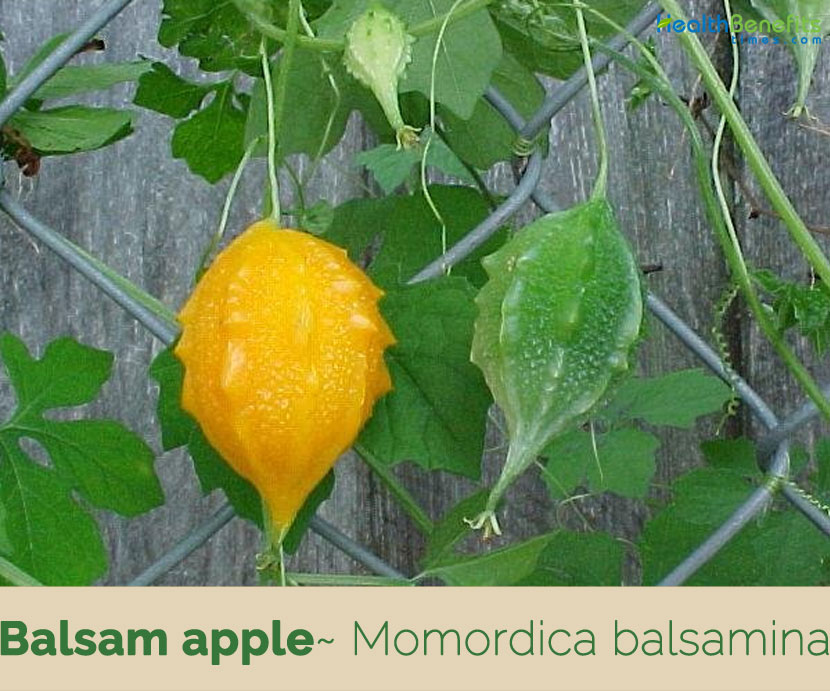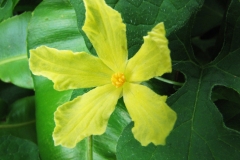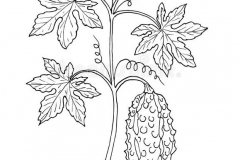| Balsam apple Quick Facts | |
|---|---|
| Name: | Balsam apple |
| Scientific Name: | Momordica balsamina |
| Origin | South Africa and tropical Africa, tropical Asia, Arabia, India and Australia |
| Colors | Green when young ripening to bright orange or red |
| Shapes | Spindle shaped, dark green with 9 or 10 regular or irregular rows of cream or yellowish short blunt spines |
| Taste | Bitter |
| Health benefits | Prevents heart disease,Supports for healthy skin,Boosts immune system, Improves vision, Protects digestive system, Strengthens bones, Helps to lose weight, Promotes hair growth |
| Name | Balsam apple |
|---|---|
| Scientific Name | Momordica balsamina |
| Native | South Africa and tropical Africa, tropical Asia, Arabia, India and Australia |
| Common Names | Balsam apple, Bitter apple, Southern balsampear, African cucumber, balsam pear, balsamina, common balsam apple, bitter melon, cundeamor |
| Name in Other Languages | Afrikaans: Laloentjie Angami: Kariela Arabic: Maedudat bilasmia (معضوضة بلسمية) Chinese: Jiao ku gua Cuba: Cundeamor English: Balsam apple, Bitter apple, Southern balsampear, African cucumber, balsam pear, balsamina, common balsam apple, bitter melon, cundeamor French: Concombre balsamite, Courgette africaine, Pomme de merveille, Margose à pomme de merveille, Momordique à feuilles de vigne, momordique commune, German: Balsamapfel, Gemeiner Balsamapfel, Gemeiner Balsamkuerbis, Wunderapfel Hausa: Garafuni Hebrew: Le’usit metappeset, לְעוּסִית מְטַפֶּסֶת Hindi: Bad kareliya (बाड़ करेलिया), Bara-karela (बड़ा करेला), Jangli-karela (जंगली करेला), Kankero, Mokha (मोखा) Indonesian: Peria Kecil Italian: Pomo meraviglia, pomo balsam, pomo di merviglia Kannada: Huchhu thonde balli (ಹುಚ್ಚುತೊಂಡೆ (ಬಳ್ಳಿ), Kaarchi balli (ಕಾರ್ಚಿ (ಬಳ್ಳಿ), Cheelaita (ಚೀಲೈತ) Malay: Peria, Peria kechil, Periok Malayalam: Kāṭṭupāval (കാട്ടുപാവൽ), Undapaval, Kaippanpaval Marathi: Karla Mozambique: Cacana Nepali: Karelaa, Barela (बरेला) Nigeria: Garafuni Pakistan: Jangli karela, keerelo-jangro Polish: Przepękla pospolita Portuguese: Balsâmina-de-purga, balsamina pequena Russian: Momordika bal’zamicheskaya (Момордика бальзамическая) Saudi Arabia: Mokah South Africa: Intshungu, intshungwana yehlathi, mohodu, nkaka Spanish: Balsamina Swedish: Balsamgurka Tamil: Parpakal Urdu: Jangli karela USA: Southern balsampear, wonder-apple |
| Plant Growth Habit | Trailing or climbing, monoecious, annual or short-lived perennial tendril-bearing herb |
| Growing Climates | Coastal bush land on sand, in woodland, wooded grassland and riverine fringes, on river banks, in dry river beds, disturbed areas, hammocks, roadsides, fencerows, grassland, savannah, forest margins |
| Soil | White, yellow, red and grey sandy soils, also in loam, clay, alluvial, gravelly and calcareous soils. It requires a soil rich in organic matter if optimum yields are to be achieve |
| Plant Size | Up to 5 metres long |
| Stem | Prostrate or scandent, to 2·7 m, finely, rather sparsely crispate-pubescent, especially at nodes |
| Leaf | Broadly ovate, reniform or orbicular in outline, cordate, usually somewhat pubescent, 10–90 mm. long and 12–120 mm. broad |
| Flowering season | August and November in Pakistan May to September in the USA June to July in Australia |
| Flower | Solitary, male and female flowers on the same plant (monoecious). Male flowers are prominently bracteate (subtended by a leaflet), bract ± ovate, to 18 mm long. Female flowers are inconspicuously bracteate, corolla rather smaller than males. |
| Fruit Shape & Size | Spindle shaped, dark green with 9 or 10 regular or irregular rows of cream or yellowish short blunt spines |
| Fruit Color | Green when young ripening to bright orange or red |
| Flesh Color | Red pulp |
| Seed | Ovate in outline, rather compressed, up to 11 mm long, light brown, surface sculptured |
| Taste | Bitter |
| Plant Parts Used | Leaves, fruits, seeds, and bark |
| Season | October to May |
| Health Benefits |
|
| Precautions |
|
Plant Description
Balsam apple is a trailing or climbing, monoecious, annual or short-lived perennial tendril-bearing herb that normally grows up to 5 meters long. The plant is found growing in coastal bush land on sand, in woodland, wooded grassland and riverine fringes, on river banks, in dry river beds, disturbed areas, hammocks, roadsides, fencerows, grassland, savannah and forest margins. The plant is found growing in white, yellow, red and grey sandy soils, also in loam, clay, alluvial, gravelly and calcareous soils. It requires a soil rich in organic matter if optimum yields are to be achieve. The plant has soft stems and tendrils that climb up shrubs, boundary fields and fences. Stems are prostrate or scandent, to 2·7 m, finely, rather sparsely crispate-pubescent, especially at nodes. It is velvet-hairy to becoming hairless.
Leaves
Leaf-blade are broadly ovate, reniform or orbicular in outline, cordate, usually somewhat pubescent, 10–90 mm. long and 12–120 mm. broad, palmately 3–5-lobed to about the middle or below, with the lobes broadly ovate- or elliptic-rhombic in outline, narrowed below, sharply sinuate-dentate or dentate-lobulate and the apices and marginal teeth apiculate. Petiole is pubescent and 4–60 mm. long. Leaves are waxy, lower surface is paler than upper surface.
Flower
Flowers are solitary, male and female flowers on the same plant (monoecious). Male flowers are prominently bracteate (subtended by a leaflet), bract ± ovate, to 18 mm long, pallid, green-veined, calyx green to purplish-black, corolla white to yellow, apricot or orange, green-veined, with grey, brownish or black spots near the bases of the three inner petals, 10-20 mm long, anthers orange. Female flowers are inconspicuously bracteate, corolla rather smaller than males. Flowering normally takes place in between August and November in Pakistan, May to September in the USA and June to July in Australia.
Fruit
Fertile flowers are followed by spindle shaped, dark green with 9 or 10 regular or irregular rows of cream or yellowish short blunt spines, ripening to bright orange or red, 25-60 mm long; opening automatically more or less irregularly into three valves that curl back (also opens when the tip is touched). Seeds are ovate in outline, rather compressed, up to 11 mm long, light brown, surface sculptured. The fruit is eaten by birds, ants, probably by some mammals (though not recorded) and also by humans.
Health benefits of Balsam apple
Additionally, there are numerous surprising health benefits of balsam apple fruit which are listed below:
1. Prevents heart disease
Balsam apple fruit has no cholesterol and less fat that perhaps helps to protect the heart. Heart diseases commonly occur when the body has an excessive amount of fat including cholesterol and consequently, the fruit may prevent them.
2. Supports for healthy skin
As previously mentioned Balsam apple fruit is equipped with vitamin C and it supports for healthy skin. It gives you smooth and soft skin as well as protects it from pimples or acne. Since then, the fruit is appropriate for women who are likely to have a healthy skin.
3. Boosts immune system
Vitamin C is one of antioxidants that are common with its ability to boost immune system, where you can find it in balsam apple fruit. Immune system is significant thing and therefore the fruit is recommended for those who are having many activities. For the best result, it is better to combine the consuming of the fruit with other healthy foods.
4. Improves vision
Vision will improve by consuming balsam apple fruit because the fruit consists of vitamin A about 54 IU, or you can read in vitamin a benefits. Additionally, it also supported by other antioxidants that can prevent some conditions such as cataract and even for night blindness.
5. Protects digestive system
Fiber is a substance that is known to protect digestive system in the body. Balsam apple fruit has 2.40 gram dietary fiber which would be enough to take care of your digestive system from some conditions. When the digestive system is healthy then it promotes overall health, since many essential nutrients absorbed well in the body.
6. Strengthens bones
Balsam apple fruit helps to strengthen bones due to vitamin K, as well as other antioxidants. Bones will get stronger not only by sufficient amounts of calcium but also vitamin K, where most of people don’t concern about it. Additionally, that vitamin also protects bones from such condition like osteoporosis.
7. Helps to lose weight
The combining of less fat and lots of dietary fiber makes balsam apple fruit can help you to lose weight. Actually many fruits are recommended by the doctor as diet treatment, including for balsam apple fruit. The reason is because some fruits have more vitamins and less of cholesterol and fat which would be beneficial for the health of the body.
8. Promotes hair growth
Vitamin C found adequately in balsam apple fruit helps in promoting hair growth. The fruit probably prevents the hair from hair loss that it may lead to a healthy hair. As the hair is strong, your hair may thicken and also can increase the confidence.
Traditional uses and benefits of Balsam Apple
- It is commonly used as an anthelminthic, and in the treatment of fever, uterine bleeding, syphilis, rheumatism, hepatitis, skin disorders, and stomach and intestinal complaints.
- It is used in the treatment and prevention of hypertension and diabetes mellitus.
- Fruit pulp has been used as an antiviral agent for poultry and even to treat human AIDS in Nigeria.
- Leaf and fruit extracts also show anti-plasmodial activity and are used against malaria in African traditional medicine.
- Concoction made by infusing the fruit (minus the seed) in olive or almond oil, is used as an ointment for chapped hands, burns and hemorrhoids.
- Whole plant is used to treat diabetes and dysentery in Mexico.
- Plant is also modified to treat skin issues like Eczema, Vaginitis, hemorrhoids, itchy rashes, Leprosy and much more.
- Leaves are also used to treat Malaria, stomach pain, cold, cough, fever and measles.
- People suffering from vaginal discharge, Colic, Menstrual problems also seek the help of the Balsam Apple.
- This fruit can also be used to induce abortions.
- Aqueous leaf extract has also been used in reducing and relieving period pain in young girls.
- Whole plant is used as sponge in treating skin disease such as scabies and as tranquilizer in the treatment of mental illness.
- Pulverized plant is applied externally against malignant ulcers.
- Leaves are used for liver deficiencies, blood cleanser/detoxifier, ulcers of the stomach and duodenum, hepatitis A and B, inflammations, marsh fever, urinary tract infections and bile disorders.
- It is taken by mothers of newborn babies to boost the production of mother’s milk.
- It was used in the Okavango delta and else-where for abortion, boils, burns, chapped hands and feet, external sores, frostbite, hemorrhoids, headache, and as a purgative.
- In U.S.A. compounded with olive or almond oil it has been used for chapped hands and for piles.
- Seed soaked in water and then inserted in the neck of the womb is a method of producing abortion practiced by the Mbula tribe of N Nigeria.
- The fruits are used in Syria for healing wounds.
Culinary Uses
- Leaves and young fruits are eaten cooked as a leafy vegetable in Cameroon, Sudan and southern Africa.
- They are often mixed with groundnut meal or added to porridge.
- Bright red fruit pulp is eaten in Namibia.
- The leaves and immature fruits are used in sauces and soups.
- It is cooked and used as a vegetable.
Other Facts
- Leaves and stems have been used to feed camels, goats and sheep but horses avoid it.
- Leaf sap is apparently a useful metal cleaner and has been used as soap to wash hands and body.
- In the past, the whole plant has been used as an ingredient in arrow poison with Strophanthus.
- The leaves and stems serve as camel fodder.
- The fruits are used as a soap substitute.
References:
https://www.itis.gov/servlet/SingleRpt/SingleRpt?search_topic=TSN&search_value=22398#null
https://npgsweb.ars-grin.gov/gringlobal/taxon/taxonomydetail?id=24519
https://www.cabi.org/isc/datasheet/34677
https://www.botanical.com/botanical/mgmh/a/apple045.html
https://www.plants.usda.gov/core/profile?symbol=MOBA
https://www.prota4u.org/database/protav8.asp?g=pe&p=Momordica+balsamina+L.
https://gd.eppo.int/taxon/MOMBA
http://www.theplantlist.org/tpl/record/kew-2372858
https://en.wikipedia.org/wiki/Momordica_balsamina
https://www.flowersofindia.net/catalog/slides/Balsam%20Pear.html
http://pza.sanbi.org/momordica-balsamica
-
7.7











